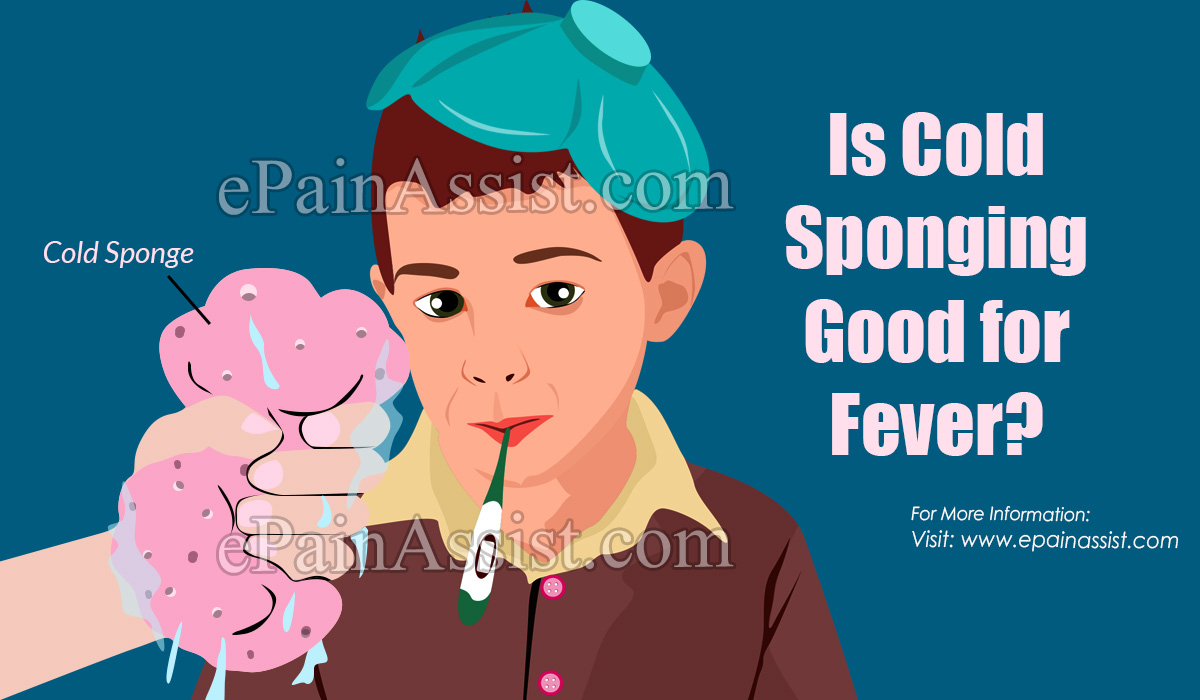Cold sponging and cold compresses is a commonly used natural remedy to bring down fever. It is done by placing a damp wash cloth soaking in cold water over the forehead or other body parts. This method is often effective in bringing down the temperature; however, it is important to do this method the right way for maximum benefit and minimum complications. Cold sponging works on the principle of cooling water which has the property to lower the temperature of a surface with direct contact.

Is Cold Sponging Good for Fever?
It is important to differentiate cold compresses from cold sponging or tepid sponging. Both these procedures are quite similar to each other except for the temperature of the water used to soak the damp cloth. Cold compresses use ice cold water and cold sponging uses cool/tepid water but not cold water. While cold sponging is good for fever, cold compresses with ice cold water should be avoided.
Studies have shown that sponging helps in controlling the body temperature. This is because water has the property to cool the body 20 times more than air. This is in turn because of evaporation of water from the surface of the skin, providing a cooling sensation, and thus extracting heat from inner body and overall reduction of body heat.
Cold sponging should be done with water at cool to normal temperature (between 65°F to 85°F). The effect of cold sponging is rapid reduction in body heat. The drawback of this method is, the effect is short lived and repeated sponging is often required.
Cold sponging should never be done with extremely cold water or ice cold water. With ice cold water, the fall in temperature is too rapid and it can cause constriction of blood vessels. This will cause retention of body heat rather than heat exchange. The outer surface of the body may appear cooler, but the internal heat would be still high, and thus won’t help the condition. Cold water can also cause shivering in some patients, which may add further heat in the body.
Procedure for Cold Sponging
Materials Needed:
- Tepid water
- Wash basin
- Large rubber mackintosh to cover the whole length of the bed
- Bath towel
- Bucket for collecting the used water.
Cold Sponging Fever Procedure:
- Inform the patient about the procedure
- Remove the patient’s clothing
- Put the rubber mackintosh over the bed and place the patient over the mackintosh
- Dip the bath towel in the wash basin with tepid water
- Bath the face followed by the upper body and then the lower body
- Place the cool towel over the armpits and groin
- Change the cloth when it is warm and repeat if necessary
- Discard the water when warm
- Do not towel dry the body, but let it air dry
- If required, light dabbing with a towel may be done
- The entire procedure takes about 15 to 20 minutes.
For cold sponging a child, place the child in a tub with 1 to 2 inches of tepid water. Use a clean wash cloth to sponge the baby. Spread a film of water over the arms, legs and trunk of the child.
Conclusion
Cold sponging is often helpful in controlling the body temperature provided it is done the right way. Chilled water should be avoided and the sponging should be done with tepid water. Placing a damp wash cloth over the forehead may not be enough; the entire body should be sponged. It is important to remember that cold sponging is not a treatment for fever. It is used in conjunction with other treatment to control the body temperature. Medications may be needed to fight against the viruses and bacteria which may cause the disease.
Also Read:
- Valley Fever or Coccidioidomycosis: Causes, Risk Factors, Symptoms, Diagnosis, Treatment, Prevention
- What is Mediterranean Spotted Fever or Boutonneuse Fever?
- What is Q Fever: Treatment, Recovery, Signs, Symptoms, Causes, Prevention, Epidemiology
- Acute Fever: Causes, Symptoms, Treatments, Diagnosis
- What is Yellow Fever, Know its Causes, Symptoms, Treatment, Prognosis
- African Tick Bite Fever: Causes, Symptoms, Treatment, Precautions, Diagnosis, Who is at Risk
- What is Hay Fever, Know its Causes, Symptoms, Treatment, Prevention, Pathophysiology, Risk Factors
- Rift Valley Fever: Causes, Symptoms, Diagnosis, Treatment
- What is Parrot Fever (Psittacosis) & How is it Treated?|Causes & Symptoms of Parrot Fever (Psittacosis)
- How is Viral Hemorrhagic Fever Transmitted & is it Contagious?
